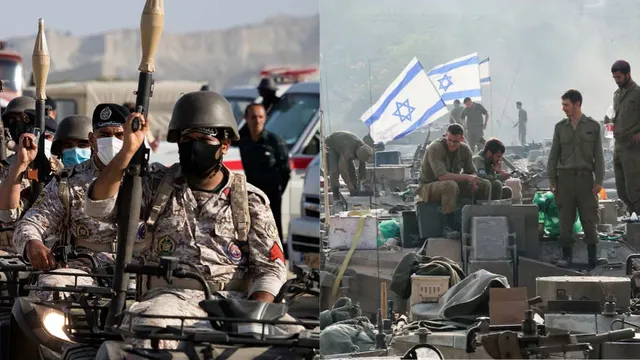- By Supratik Das
- Sat, 14 Jun 2025 10:31 AM (IST)
- Source:JND
Israel-Iran war: Predawn air‑raid alarms howled through central Israel on Saturday as Iran fired a fresh barrage of ballistic missiles and attack drones at Tel Aviv, Jerusalem, and strategic airbases, triggering deployment of Iron Dome, David's Sling, and Arrow interceptors. The salvo was the third substantial exchange in 48 hours and indicated that the long‑running shadow war has broken into open conflict. Within the course of two evenings, the region has witnessed back‑to‑back missile attacks. Iran's Revolutionary Guards code‑named Friday's counterattack "True Promise 3", launching about 150 ballistic missiles in addition to swarms of Shahed‑series drones. Israeli emergency aid service Magen David Adom reported over sixty casualties and a single fatality following fragments hitting residential neighborhoods; early Saturday morning launches added at least seven more civilian deaths.
The escalation started at 01:30 a.m. local time on 12 June when Israel launched Operation Rising Lion, a coordinated wave of strikes on nuclear and military installations deep within Iran. The strikes killed Islamic Revolutionary Guard Corps (IRGC) Commander in Chief Hossein Salami, IRGC Aerospace Force commander Amir Ali Hajizadeh, Armed Forces Chief of Staff Mohammad Bagheri, and former Atomic Energy Organisation chief Fereydoon Abbasi.
Manpower: Numbers Versus Mobilisation
Iran constitutes roughly 600,000 regular and IRGC troops, backed by an estimated 300,000 reservists and Basij volunteers. Israel keeps only about 170,000 active personnel but can mobilise 460,000 reservists within 48 hours with a nationwide conscription system and digitised call‑up network.
Air Supremacy: F‑35I 'Adir' Tipped the Balance
The Israel Defense Forces' Air Force has over 600 combat aircraft in its fleet, including fifth-generation F‑35I stealth fighter jets, upgraded F‑15I Ra'am strike fighters, and F‑16I Sufa multirole fighters, and they are sustained by tanker and AWACS fleets. This enabled Israel to shut down Iranian radars on Wednesday night and break through to Natanz. Iran has been suffering by decades of sanctions, operates an aging combination of F‑4s, MiG‑29s, and locally modified Saeqeh fighters; only a few newly arrived Russian Su‑35s are thought to be operational.
Tehran possesses the Middle East's largest stockpile of ballistic missiles, ranging from short‑range Fateh‑110s to 2,000‑km solid‑fuel Sejjils, and has sent Shahed‑136 loitering missiles to proxies and Russia for use in Ukraine. Israel’s missile force is smaller but focuses on precision systems such as LORA and the Jericho‑3 strategic deterrent, while its combat‑proven Hermes and Heron drone families give real‑time strike capability.
Missile Defence: Israel's Multi‑Layer Shield Holds
Iron Dome, David's Sling, and Arrow‑2/3 have destroyed thousands of incoming projectiles since 2011, and Israeli and American services report approximately. 90 per cent interception rates above during this week's barrages, restricting damage mainly to debris fallout. Tehran's network integrates imported S‑300s with domestically produced Bavar‑373 and Khordad‑15 batteries, yet Wednesday’s strikes penetrated key sites with little resistance, raising doubts about radar coverage and command fusion.
Proxies Extend Tehran's Reach
Iran's "Axis of Resistance", Hezbollah in Lebanon, Hamas and Islamic Jihad in Gaza, Iraq and Syria Shia militias, and the Houthis in Yemen, gives strategic depth. Hezbollah alone has an estimated 150,000 rockets arrayed north of Israel's border. Israel, without such proxies, depends on precision strikes, cyber, and intelligence alliances to prevent several fronts from destruction.
ALSO READ: 'Will Deal A Heavy Blow': Ayatollah Khamenei Issues Dire Warning To Israel After Attacks
Unit 8200 Vs IRGC Cyber Corps
The Unit 8200, Shin Bet, and Mossad of Israel synchronise signals intelligence with kinetic attacks, a harmony illustrated by the destructive Stuxnet worm and the precision-killed IRGC commanders in Syria. Iran's cyber forces have, in turn, attacked Israeli water supplies, US banking systems, and Saudi oil facilities, proving capable of inflicting economic damage without leaving marks.
Nuclear Shadow Lengthens
Israel follows a decades‑old policy of “nuclear ambiguity” but is widely assessed by SIPRI to possess between 75 and 400 nuclear warheads deliverable by Jericho missiles, Dolphin‑class submarines, or dual‑capable aircraft. Iran has no declared bomb, but according to an IAEA briefing to the Board of Governors in March, it now stocks about 275 kg of uranium enriched to 60 per cent, which is enough for six nuke weapons.
Defence Spending And Sustainment
Despite the population imbalance, Israel's defence budget each year is approximately 24 billion USD, over twice that of Iran's 10 billion USD, supporting repeated high-tech acquisitions and multi-year training cycles.
This reveals the Jewish state having superiority in air power, missile defense, cyber capabilities, and most importantly, an assumed nuclear deterrent. Iran compensates with manpower, missile volume, and an extensive proxy ecosystem that forces Israel to divide attention across multiple fronts. As each side exchanges direct blows for the first time, the determining question is not which is more powerful on paper, but whether either is capable of giving a strategic beating without triggering a broader regional fire. Israel's qualitative advantage thus far is still holding, but Iran's ability to drag out and widen the battle means that any absolute "upper hand" might be temporary.

